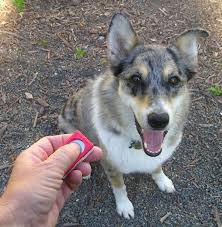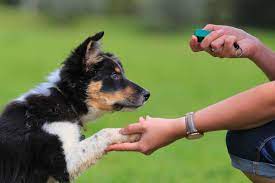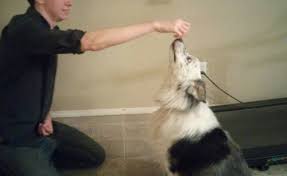What is Clicker Training?
The clicker is a small device that makes a click or chirp when pressed. It can be used to communicate to your dog that he has done something you like AND he is going to get a reward for it. So clicker training dogs is setting up a communication system your dog can understand. It sounds so simple, and it truly is! It is also very powerful.

Why does it work?
Clicker training dogs works because it takes a lot of the mystery out of what we want, from the dog’s point of view. Your dog will quickly learn that the click means something great is going to happen–a yummy treat, his favorite toy, something he really likes. And he will learn he can make that click happen by doing what you seem to be asking him to do!
I used to “load the clicker”–click and deliver a treat, repeat about 10 times. There is nothing wrong with that, and I think most people start off with that. I now generally just go right to using the clicker for something the dog knows (if he has any training at all), or to using it to train the sit.
Timing matters
The click should come as the dog is doing the behavior or as soon after he has done it as possible. So timing matters. But timing takes time to develop, and you will get comfortable with it. I know my timing isn’t always great, but it’s okay enough of the time that my dogs learn.

The click comes as the dog does the behavior we want. Then he gets the reward. We want the dog to associate the click with the behavior “ha, I got it right”, and to predict the reward “goodie, I’m getting a cookie”. If you click and treat at the same moment, the dog will be focused on the reward, and the marker value of the click will be less powerful.
Marker? What’s that?
The clicker is a marker–it communicates “yes, that’s what I want”. It is also a bridge between the behavior and the reward. The click marks that the behavior is what you want, and signifies that the reward is coming, and it is for that behavior.
So let’s say we have asked our dog to lie down, and click as he does. Then we have to fumble in our pocket for his treat. If there is a several second delay in delivering the treat, he will still understand it was for lying down.
Do I have to use the clicker forever?
The clicker is great for training new behaviors. It makes it very clear to the dog when he has done what you wanted. Once a dog knows a behavior, there really isn’t any reason to keep using the clicker for most behaviors. For instance, once my dog knows how to sit on cue I don’t need the clicker for sitting anymore.
What if I don’t have a clicker with me?
One objection I often hear is that you may not always have the clicker with you. I use a word as a marker word, that works just as a clicker does. I recommend the word “YES”, as you can say it differently than you would in conversation, and it works well. I don’t recommend “good” as a marker word, because I hope you say it a lot–“Good girl, what a good dog”. Remember, a marker predicts a reward. If you use your marker (clicker or marker word) without a reward, you will weaken it. Your deal with your dog is a marker means “you did it, and you are getting a reward”.
What is the difference between a marker and praise?
A marker, clicker or word, predicts a reward. Praise doesn’t necessarily predict a reward, although it may lead to one. So if I didn’t have a treat or toy with me, and I asked for a behavior, I wouldn’t use a marker, I would use praise. “Rover, come”, “Yay , good dog, what a boy!” with enthusiasm and pats when he comes.
Research has shown that when teaching a new behavior:
*The clicker is the most effective method, probably because the noise is so distinct.
*A marker word is a very close second.
*Praise is effective, but not as efficient as the clicker or marker word.
Use your clicker!
So let’s try using the clicker. If your dog knows a cue to sit, practice your timing with the clicker. Ask for the sit, and when his bottom hits the floor, click, then deliver a treat. He’ll soon understand the meaning of the click.
If your dog doesn’t already have a sit, take a treat and holding it right over his nose move it back towards his ears. Try to keep it close to his nose so he follows it, but without letting him grab it. Go slowly, and most dogs will sit down. The moment his bottom hits the floor, click, then let him have the treat.
 If he tries to jump for the treat, it is probably too high. If he just backs up, try starting with him in a corner. You may have to play with it a bit, but most dogs will sit with this method.
If he tries to jump for the treat, it is probably too high. If he just backs up, try starting with him in a corner. You may have to play with it a bit, but most dogs will sit with this method.
Luring a behavior
Teaching the sit in this manner is an example of luring a behavior. You are using a treat to lure the dog into doing what you want. So for the sit, we lure the dog with a treat over his head, his bottom hits the ground, and you click, then treat.
One of the most important parts of luring a behavior is turning the lure into a reward as soon as you can. What do I mean by that? Once you are pretty confident your dog will sit with a lure, get the treat into the other hand. So you lure with an empty hand, and when the dog sits, click and treat from the other hand. You may have to put the treat back in the luring hand occasionally–for instance, if there are a lot of distractions.
When do I add the cue?
What started as your lure gesture easily turns into a hand signal or cue. You can modify it at this point into what you want. For the sit, my hand cue is my hand palm up, moving up. That is what it did with the treat. Many people use a fist or a pointing finger. It doesn’t matter, so long as you are consistent.

I am quiet until the dog will physically do the behavior. In other words, I may talk to the dog, but I don’t say “sit, sit, sit” as I’m luring him to sit. That turns the word sit into background noise your dog learns to ignore!
When he will sit with the lure, I say “sit” once as I lure him into the sit. Then I start saying “sit” and pausing a second before using the hand cue. The dog will soon make the association and be sitting on the verbal cue, not waiting for the hand signal.
Bribery vs Rewards
Once a dog knows a behavior pretty well, you want to have the treat out of sight while asking for the behavior–in your pocket, or a treat pouch, or at least behind your back. At first, you still reward the dog each time he does the behavior when asked. You definitely don’t want the dog to get the idea that if he doesn’t see a treat he won’t get one. That ends up being the dog who checks to see if there is a treat before he responds to the cue. That is when rewards have turned into bribery.
Intermittent rewards
When the dog really understands the cue, and is consistently performing the behavior when asked, you can begin to fade out the reward, and go to intermittent rewards. In other words, the dog gets a treat or toy reward some of the time, but only praise some of the time. I always give feedback that he responded correctly–in other words I acknowledge that he did it.
Many trainers start by rewarding 2 out of 3 times, or some numerical system. I start by occasionally not giving a treat, just a “good girl”. Then I reward when the dog does it especially well, or when it’s really hard–there was a distraction, but she did it. When the dog has several behaviors on cue, I start doing chains of behaviors. The times the dog doesn’t get a treat, I’m very upbeat and cheerful. Dogs love your enthusiasm, and will work hard to get that reaction from you!
Make it a game!
Once a dog knows several behaviors on cue, I make it a game. I’ll ask for 1 or 2 things he knows, then treat. Then 1 thing/treat. Then 3 things/treat. Then 2 things/treat, etc. I’ll use a verbal cue for some and a hand signal for some. Its rapid fire and most dogs love it. It’s only for a couple of minutes, but you get a lot of training in that short time, and build the dog’s desire to work with you.
Be sure to stop while the dog is still having fun. I can’t empathize this enough. Always try to end your training while you and the dog are having fun. Leave the dog wanting more!
Try it out.
If you haven’t tried clicker training before, I hope this gets you interested. This is the most basic of introductions to it, but I hope you find it helpful. I would love to hear about your experiences with it, so feel free to add some comments. Happy training!
I have been clicker training my labrador for about 3 weeks now and I have to say that it works like a charm. I have never been able to get her attention as well as I do with the clicker Ive got now so im hoping this will be the time she behaves for me, great article, thanks
Hi Mathew,
Glad the clicker is working for you and your dog. It is such a great way to provide clear communication between you. Often when dogs aren’t listening to their owners, it’s because they don’t understand the requests, or don’t realize that it pays to listen. As she gets more consistent responding to cues, you can reward intermittently, so you don’t have to have a treat available all the time. Be sure if you click though, you treat. That’s the deal with our dogs!